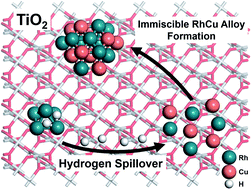Synthesis of a binary alloy nanoparticle catalyst with an immiscible combination of Rh and Cu assisted by hydrogen spillover on a TiO2 support†
Abstract
This work demonstrated the use of TiO2 as a promising platform for the synthesis of non-equilibrium RhCu binary alloy nanoparticles (NPs). These metals are regarded as immiscible based on their phase diagram but form NPs with the aid of the significant hydrogen spillover on TiO2 with concurrent proton–electron transfer. The resulting RhCu/TiO2 exhibited 2.6 times higher catalytic activity than Rh/TiO2 during hydrogen production from the hydrolysis of ammonia borane (AB), due to a synergistic effect. Theoretical simulations showed a higher energy value for the adsorption of AB on the RhCu alloy and a lower activation energy for the rate determining N–B bond dissociation by the attack of H2O during AB hydrolysis compared to monometallic Rh. High-angle annular dark-field scanning transmission electron microscopy and energy-dispersive X-ray spectroscopy confirmed the formation of RhCu alloy NPs with a mean diameter of 2.0 nm on the TiO2. H2-temperature programmed reduction and in situ X-ray absorption fine structure analyses at elevated temperature under H2 demonstrated that Rh3+ and Cu2+ precursors were simultaneously reduced only on the TiO2 support. This effect resulted from the improved and limited reducibility of Cu2+ and Rh3+, respectively. The rate of hydrogen spillover of TiO2 is faster as compared to γ-Al2O3 and MgO as evidenced by sequential H2/D2 exchanges during in situ Fourier transform infrared analyses. Density functional theory calculations also showed that the migration of H atoms on TiO2 proceeds with a lower energy barrier than that on Al2O3, and the reduction of Cu2+ species is facilitated by H spillover on the support rather than by direct reduction by H2. These results confirm the vital role of TiO2 in the formation of the alloy and may represent a new strategy for the synthesis of different non-equilibrium solid solution alloys.



 Please wait while we load your content...
Please wait while we load your content...